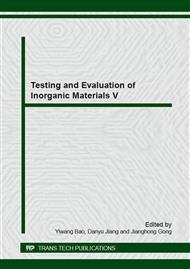p.443
p.447
p.451
p.455
p.459
p.463
p.467
p.472
p.476
Influence of Specimen Size on the Impulse Excitation Technique
Abstract:
The Impulse Excitation technique is a nondestructive and very convenient testing method. It could be applied at different circumstances such as high temperatures, low temperatures and controlled humidity. The Impulse Excitation technique is based on the analysis of the vibration of a test sample after it was impulse excited. The elastic properties of a test specimen are related to its mechanical resonance frequency. In this paper, the regular of resonance frequency changed with specimen’s size was discussed. Elastic modulus of glass with different length, width and thickness were measured, and ceramic composite material with small size was tested. The results indicate that the resonance frequency of specimen changed with its size regularly, and the specimen with small size has poor accuracy of elastic modulus measurement.
Info:
Periodical:
Pages:
459-462
Citation:
Online since:
November 2014
Authors:
Keywords:
Price:
Сopyright:
© 2015 Trans Tech Publications Ltd. All Rights Reserved
Share:
Citation:


